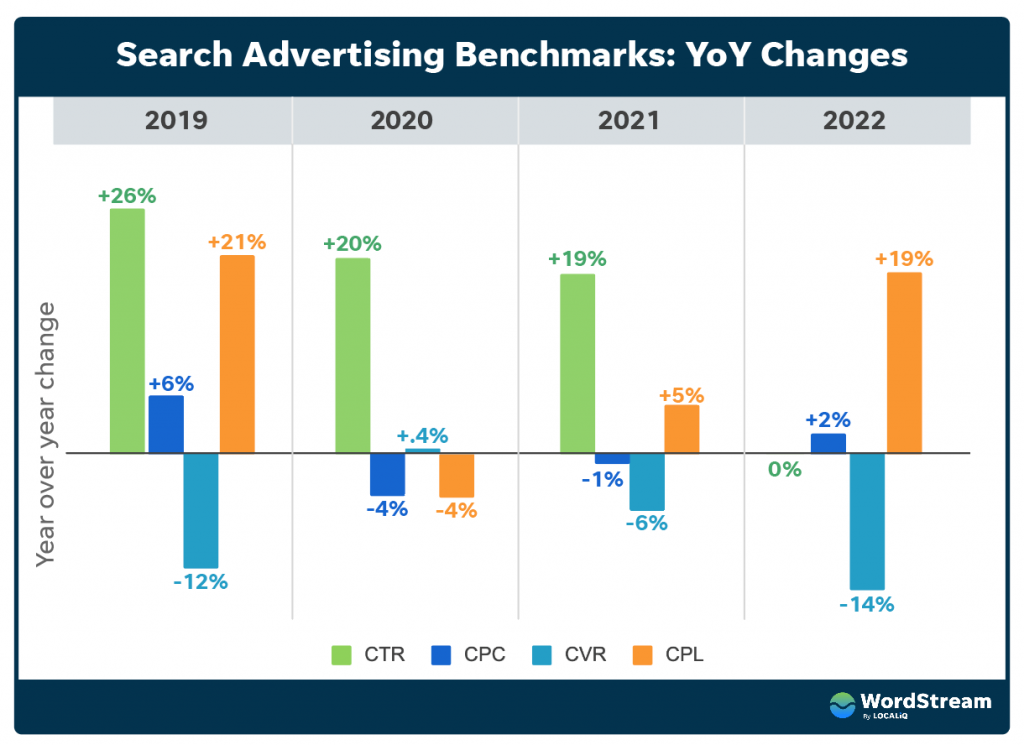For advertisers heading into the pointy end of the year, the latest data on online ad costs is enough to make the most seasoned advertiser’s eyes water.
A report from LocaliQ has shown that the cost per lead has gone up for 91% of industries advertising on Google.
If you’re in the arts and entertainment field (134% increase), travel (69% increase) and furniture (54%) increase, our hearts are truly with you.
It’s not all doom and gloom, though, as education/instruction dropped 29%, while finance/insurance companies also experienced a decline (2%).
The data was gathered from 79,000 Search ads campaigns from October 2021 to September 2022.
Cost per lead
LocaliQ dug into 23 industries and found that cost per lead is up for 21 of them, with an overall increase of 19% – a whopping figure significantly higher than 2021’s increase of 5%.
The numbers hit home even harder when you consider that 2020’s cost per lead declined by 4%, so in real terms, there’s been a 23% increase over the past two years.
Conversion rate
Not only are you paying more, but you’re also getting less.
In a case of life imitating… life, customers are left with less bang for their buck. 91% of surveyed industries saw a dip in conversation rate, with an average of 14%. 2019 also saw a conversion rate decline of 12%, so it’s safe to say that it’s been 24 months of pain for advertisers and those in charge of marketing budgets.
Conversion rate decline within paid search could be due to broad match keywords bringing in top-funnel searches that aren’t that interested in the product. Something Google has been pushing hard in recent times.
Cost per click
Cost per click is also up across 57% of industries, but only by a small amount (2%).
Compare that to 2020 (down 4%) and 2021 (down 1%), and you’ll find that cost per click has grown by 6% in two years.
Click-through rate
Click-through rates are stable, further proving that 2022 is costing more and delivering less for just about every single person or entity on this planet.
What are the primary causes that are identified behind these changes?
At this point, you’re probably wondering who to blame and if you can turn up at their office with your pitchfork and torch. If that’s you, there’s bad news as the causes are a little more nebulous.
High inflation has played its part. With prices rising, consumers are cutting back on non-essential goods and services such as eating out and travel – so it’s no surprise to see those two industries hit hard by cost per lead rises and worse conversion rates. It also explains why arts and entertainment, furniture, apparel, fashion and jewellery are doing worse than last year.
LogiciQ reckons that supply chain issues are why furniture advertisers are being hit with a higher cost per lead.
Also, Search ads are incredibly competitive. As more advertisers are fighting for customers, it’s only natural that prices increase.
How to adapt to the new normal
So, how should marketers and advertisers deal with it?
Curling up into a ball and having a little cry could be cathartic, but doing something practical will always feel better in the long run.
Here are LogiciQ’s recommendations for navigating these choppy waters:
- Make sure you’re on top of your negative keywords to ensure your ads aren’t being shown to the wrong people. Click-through rates aren’t much different from what they were two years ago, indicating that ads aren’t being shown to as many engaged people as they were before. So, stay on top of those keywords to increase audience relevance.
- Develop a full-funnel approach to help improve conversion rates. Create campaigns that drive awareness and engagement up your funnel and then nurture those leads with trust-building/retargeting campaigns to get them hooked on your business.
- If you can, increase your Search ad budget to beat your competition to find engaged, purchase-ready audiences.
- Make earned and owned media work harder, such as a Google Business Profile, beefing up your social media activity, doing local SEO (such as location-based keywords) or developing an email marketing plan.




RECOMMENDED FOR YOU
LinkedIn Streamlines B2B Influencer Marketing
LinkedIn has introduced a more intuitive way for brands…
LinkedIn has introduced a more intuitive way for brands…
Meta Adds New AI Tools To Supercharge Lead Gen
Meta is rolling out a wave of updates to…
Meta is rolling out a wave of updates to…
Meta Uses AI Chats To Refine Ad Targeting
Meta has announced a major update to how it…
Meta has announced a major update to how it…